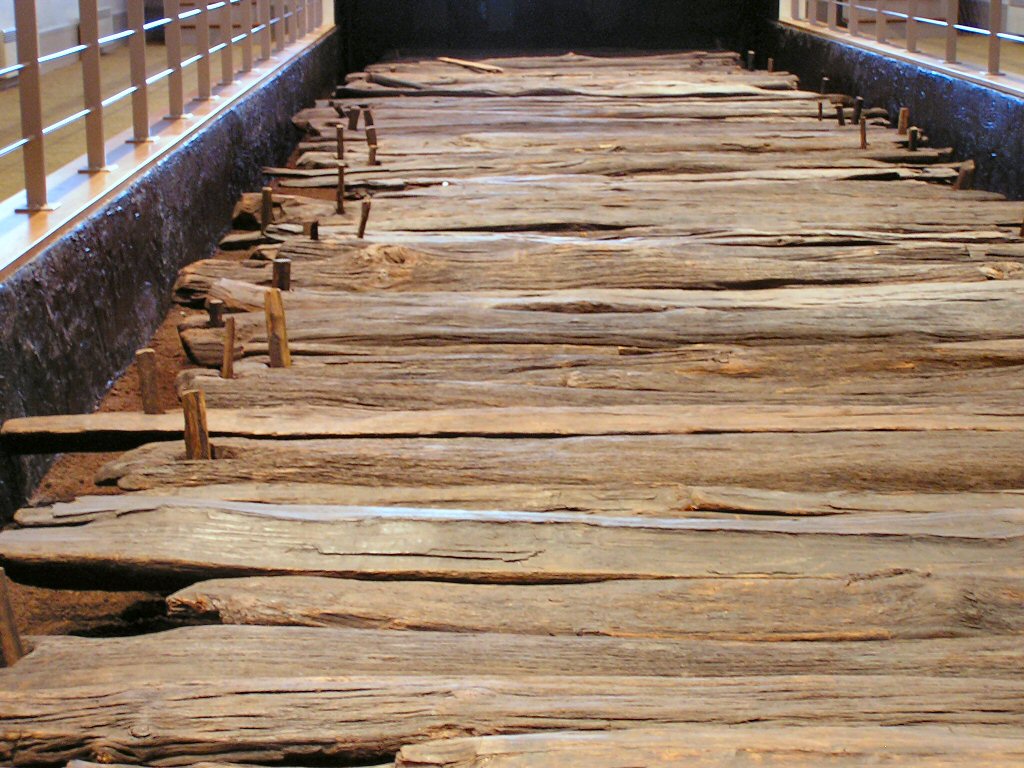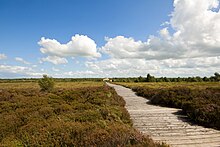Wittmoor bog trackway
With plank from the Wittmoor two prehistoric boardwalks are referred to the 1898 ( Bohlenweg I) and 1904 ( boardwalk II) were discovered in Wittmoor in the north of Hamburg. The boardwalks are from the 4th to the 7th century AD, linking the east with the west bank of the then difficult to access, marshy bog. Some of the older, dating from the Roman Iron Age planks path II is shown in the permanent archaeological exhibition of the Archaeological Museum Hamburg in Hamburg- Harburg.
Locality
The locations of both boardwalks are in Wittmoor, located in the area of Hamburg districts Duvenstedt and Lemsahl - Mellingstedt, and extends to the Schleswig-Holstein region, up to the district of Norderstedt, glassworks. The degradation of peat parts of a historical path planks were cut in Wittmoor over again. 1898 followed the schoolmaster and local historian Ludwig Frahm pointing the Poppenbuetteler carpenter Hinrich Mohr, who showed him the location of what he called Russians dam planks path I. In 1900, Frahm put a larger portion of the planks free path and published results of his campaigns in 1901 and 1913. Overall, two boardwalks were in Wittmoor found so far, which were excellently preserved due to storage in moist soil.
I Bohlenweg
The boardwalk was 1898 I discovered, exposed in the years 1900 and 1901 by Frahm together with Prof. Wilms partially and studied in the 1930s, again by the archaeologists Prejawa and Kolumbe. The road ran right southeasterly direction through the Wittmoor and had a length of about 500 m. During the Second World War, particularly the western part of the bog for fuel production was abgetorft amplified, with large parts of the road were destroyed with. This boardwalk was much simpler than the older boardwalk II The path consisted only of clean -hewn oak planks between 180 and 200 cm in length and 20 to 30 cm wide, which were placed directly on the surface of the bog without beams. The boardwalk was embedded only 1 m below the ground surface in the peat. Also in this part of the moor peat was mined regularly for fuel production, the path was also destroyed gradually. The well-preserved wooden planks of the road were used by the peat cutters as firewood. Location: 53 ° 42 ' 10.2 " N, 10 ° 4' 18.2 " O53.70282910.071716
Boardwalk II
The Bolenweg II was discovered in 1904 by the Hamburg state geologist Dr. Wolff. This also ran southeasterly direction, about 500 m south-southwest and nearly parallel from the boardwalks I, by the Wittmoor. This had a length of about 600 m. This way too, was destroyed gradually by regular Abtorfen. 1947, Kellermann excavations at the central part of the way through and recovered an approximately 2 m long stretch, which is now shown in the permanent exhibition of the Archaeological Museum Hamburg. The substructure of the road consisted of two split oak planks, which were placed parallel to each other on a sand or gravel on the formerly swampy terrain. On the screed sleepers were laid crosswise of split oak boards from about 130 to 160 cm in length and 25 to 45 cm in width and a thickness of two to six inches for travel direction as the path area. The thresholds were notched to prevent slipping on the planks. Every second threshold was cut obliquely at the ends. Through the gaps birch sticks were driven into the ground to prevent slipping of the thresholds. Much of the excavated Kellermann way resembled a construction site, in part, the woods of the path were torn out and thrown together in one place. Beside it lay newly trimmed timbers that were intended to be installed, as well as a tool interpreted objects, such as a crowbar and mallet. Charred small pieces of wood indicate a fire pit.
1938 the boardwalk by pollen analysis was initially dated to the 6th century BC, with a radiocarbon dating in 1957, however, an age at the birth of Christ revealed. The most recent dendrochronological dating in 1996 resulted in a Fälldatum the buildings around the year 330 AD Location: 53 ° 41 ' 59.9 "N, 10 ° 4' 9.8 " O53.69998410.069399
Detail of the planks path II in the 1930s
Mortise in a Wegbohle in the 1930s
Interpretation
With the discovery of the two planks ways could the former doctrine that such paths just south of the Elbe occurred, to be corrected. Show Boardwalks found that in earlier times, a lively exchange between the western and eastern shores of the bog has taken place and the roads were considered so important that a significant logistical and material effort has been made to find ways to build through the moor instead of this to evade or avoid. Archaeological but not belonging to the boardwalks settlements have so far been detected.










